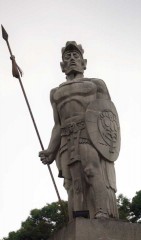Tecún Umán Monument
 Heralded as Guatemala’s national hero, Tecún Umán is a symbol of indigenous resistance, a legendary figure of Kaqchikel history who led his people into battle against the Spanish conquest of the Guatemalan Highlands in 1524 and refused to surrender.
Heralded as Guatemala’s national hero, Tecún Umán is a symbol of indigenous resistance, a legendary figure of Kaqchikel history who led his people into battle against the Spanish conquest of the Guatemalan Highlands in 1524 and refused to surrender.
Remembered for his bravery and dignity—fighting to protect his land and encouraging his people to do the same—he was defeated by conquistador Don Pedro de Alvarado but left a legacy that permeates Guatemalan life today.
Although debate remains over his historical reality, Tecún Umán is among one of the most important figures in the country’s history. Celebrated in literature, folktales and dances, and commemorated on the national currency, the Mayan king is also honored through prominent statues that guard both the entrance to Quetzaltenango and La Aurora International Airport in Guatemala City.
There are various versions of the 1524 battle between Alvarado and Tecún Umán. However, according to legend, the gallant Maya-Quiché captain, adorned with quetzal feathers and a jewelled crown, led his native army into battle accompanied by Guatemala’s national bird, the quetzal.
The warriors, from worlds apart, met face to face: Umán on foot and Alvarado on horseback. However, since Tecún Umán had never seen a horse before, he assumed the conquistador and his steed were one being. He killed the horse, thinking that its rider would be slain too, but of course Alvarado survived. The Spaniard speared his opponent in the chest and killed the Mayan king. Legend says, that strewn with grief Tecún Umán’s faithful companion, the quetzal, landed on Umán’s chest—staining his feathers red with the blood. From that day on, all male quetzals have borne a scarlet breast symbolizing the fallen warrior.
Even though he was defeated, Guatemalans revere Tecún Umán because of his honorable determination. Tecún Umán was declared Guatemala’s official national hero on March 22, 1960.
This is good, except that Tecún Umán was K’iche’, not Kaqchikel.